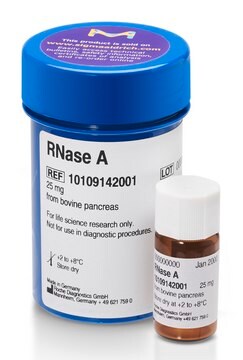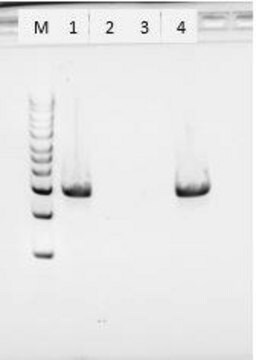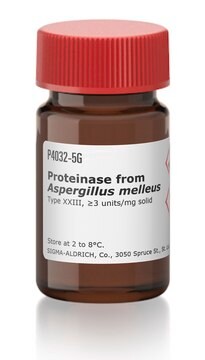RPROTKSOL-RO
Roche
Proteinase K, recombinant, PCR Grade
Solution from Pichia pastoris
Sign Into View Organizational & Contract Pricing
All Photos(1)
About This Item
Recommended Products
recombinant
expressed in Pichia pastoris
Quality Level
form
buffered aqueous solution (18 ± mg/mL; pH 7.5)
specific activity
~2.5 units/mg protein
packaging
pkg of 1.25 mL (03115887001)
pkg of 25 mL (03115844001)
pkg of 5 mL (03115828001)
manufacturer/tradename
Roche
optimum pH
6.5 and 9.5
pH range
4.0-12.5
storage temp.
2-8°C
General description
Approximately 2.5 U/mg (Chromozym assay); ≥30 U/mg hemoglobin assay. Refer to the Certificate of Analysis for specific values for the present lot.
Application
- This PCR grade Proteinase K is extremely effective on native proteins and can therefore be used to rapidly inactivate endogenous nucleases such as RNases and DNases. This property makes Proteinase K particularly suitable for the isolation of native RNA and DNA from tissues or cell lines.
- The enzyme promotes cell lysis by activating a bacterial autolytic factor.
- Proteinase K is also used for the analysis of membrane structures by modifying proteins and glycoproteins on cell surfaces.
- The enzyme is particularly well suited for isolating nucleic acids for amplification reactions.
- Proteinase K can be used to remove cellular debris during the preparation of colony lifts, and to treat tissue sections to ensure efficient probe infiltration during in situ hybridization.
Features and Benefits
Proteinase K cleaves proteins between amino acids X and Y (X-↓-Y), when X = an aliphatic, aromatic, or hydrophobic amino acid, and Y = any amino acid. The enzyme is extremely effective on native proteins and can therefore be used to rapidly inactivate endogenous nucleases such as RNases and DNases.
- Choose an effective tool for template preparation. Inactivate DNases and RNases of most species.
- Count on consistent quality and performance. Stringent quality testing ensures optimal stability and high-level lot-to-lot performance.
- Prepare samples over a wide range of conditions. The robust enzyme is stable over a wide pH range and is ideal for diverse applications.
- Benefit from a contamination-free enzyme. The enzyme is tested for the absence of RNases and DNases, and is virtually free of DNA. It is especially suited for the isolation of PCR templates.
Quality
This preparation is free of RNases, DNases, and DNA, according to the current quality control procedures.
Absence of Nucleases: Each lot is tested on various substrates to ensure the absence of endonuclease, exonuclease, ribonuclease, and nicking activity.
DNA Content: ≤10pg/mg enzyme (determined by Threshold)
Bioburden: ≤5cfu/g (determined by the most stringent test from the European Pharmacopoeia, which identifies the total number of viable aerobic bacteria, yeast, and fungi)
Absence of Nucleases: Each lot is tested on various substrates to ensure the absence of endonuclease, exonuclease, ribonuclease, and nicking activity.
DNA Content: ≤10pg/mg enzyme (determined by Threshold)
Bioburden: ≤5cfu/g (determined by the most stringent test from the European Pharmacopoeia, which identifies the total number of viable aerobic bacteria, yeast, and fungi)
Unit Definition
Volume Activity: Approximately 50 U/ml solution (chromozyme assay); approximately 600 U/ml solution (hemoglobin assay). One unit is the enzyme activity which cleaves at +25 °C in 1 min 18 mmol Chromozym TRY (equivalent to 600 U/ml with the hemoglobin assay). Refer to the Certificate of Analysis for specific values for the present lot.
Preparation Note
Activator: To stimulate proteinase K activity, denaturing agents (SDS and urea) can be added. For example, SDS at a final concentration of 2% can increase the activity of proteinase K significantly. Optimization using denaturing agents can increase proteinase activity by as much as sevenfold.
Working solution: Suggested Buffers:
The most appropriate buffer for Proteinase K will vary from application to application. Always follow the pH and temperature guidelines in parameter filed. As a general rule, proteinase K is stable and very active in buffers that contain denaturing reagents such as urea, sodium dodecyl sulfate (SDS), and guanidinium salts.
Inhibitors: The enzyme is inactivated by Pefabloc® SC. However, it is not inactivated by metal ions, chelating agents (e.g., EDTA), sulfhydryl reagents, or trypsin and chymotrypsin inhibitors.
Working solution: Suggested Buffers:
The most appropriate buffer for Proteinase K will vary from application to application. Always follow the pH and temperature guidelines in parameter filed. As a general rule, proteinase K is stable and very active in buffers that contain denaturing reagents such as urea, sodium dodecyl sulfate (SDS), and guanidinium salts.
Inhibitors: The enzyme is inactivated by Pefabloc® SC. However, it is not inactivated by metal ions, chelating agents (e.g., EDTA), sulfhydryl reagents, or trypsin and chymotrypsin inhibitors.
Other Notes
For life science research only. Not for use in diagnostic procedures.
For the rapid inactivation of RNases and DNases.
The enzyme can reduce protein to free amino acids if it is present in large excess for long incubation periods.
The enzyme can reduce protein to free amino acids if it is present in large excess for long incubation periods.
Legal Information
Pefabloc is a registered trademark of Pentapharm
Signal Word
Danger
Hazard Statements
Precautionary Statements
Storage Class Code
12 - Non Combustible Liquids
WGK
WGK 1
Flash Point(F)
No data available
Flash Point(C)
No data available
Choose from one of the most recent versions:
Already Own This Product?
Find documentation for the products that you have recently purchased in the Document Library.
Customers Also Viewed
Sungjae Hwang et al.
Cancer, 119(24), 4249-4258 (2013-10-12)
Epigenetic reprogramming of the methylome has been implicated in all stages of cancer evolution. It is now well accepted that cancer cells exploit epigenetic reprogramming, a mechanism that regulates stem/progenitor cell renewal and differentiation, to promote cancer initiation and progression.
Gerard Honig et al.
Journal of biomedical science, 17, 82-82 (2010-10-19)
Multicellular organisms are characterized by a remarkable diversity of morphologically distinct and functionally specialized cell types. Transgenic techniques for the manipulation of gene expression in specific cellular populations are highly useful for elucidating the development and function of these cellular
Shari Carmon et al.
Development (Cambridge, England), 148(24) (2021-12-18)
Morphogen gradients are known to subdivide a naive cell field into distinct zones of gene expression. Here, we examine whether morphogens can also induce a graded response within such domains. To this end, we explore the role of the Dorsal
Jian Zhang et al.
BMC developmental biology, 8, 115-115 (2008-12-18)
RNA-binding motif protein 19 (RBM19, NCBI Accession # NP_083038) is a conserved nucleolar protein containing 6 conserved RNA recognition motifs. Its biochemical function is to process rRNA for ribosome biogenesis, and it has been shown to play a role in
Caroline Meyer Olesen et al.
Microorganisms, 9(7) (2021-08-08)
Investigation of changes in the skin microbiome following treatment of atopic dermatitis (AD) with dupilumab may provide valuable insights into the skin microbiome as a therapeutic target. The aim of this study is to assess changes in the AD skin
Our team of scientists has experience in all areas of research including Life Science, Material Science, Chemical Synthesis, Chromatography, Analytical and many others.
Contact Technical Service










